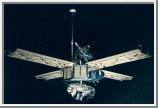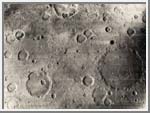
Courtesy of the Jet Propulsion Laboratory and NASA's National Space Science Data Center
Mariners 6 and 7 were designed to fly over the equator and southern hemisphere of the planet Mars. Both spacecraft were attitude stabilized in three axes (referenced to the Sun and the star, Canopus). They were solar powered and capable of continuous telemetry transmission. They were fully automatic in operation, although they could be reprogrammed from Earth during the mission. The spacecraft were oriented entirely to planetary data acquisition, and no data was obtained during the trip to Mars or beyond Mars.
Mariner 6 was launched on February 24, 1969, followed by Mariner 7 on March 27 of that year. One hundred million kilometers (62 million miles) later, Mariner 6 encountered Mars on July 31, 1969; Mariner 7 reached the planet four days later on August 4, 1969.
The two spacecraft transmitted to Earth a combined total of 143 approach pictures of the planet and 55 close-up pictures. The closest approach to Mars for both spacecraft was approximately 3,550 kilometers (2,200 miles) above the planet's surface. The pair of spacecraft studied the Martian atmosphere and profiled its chemical composition. Television cameras spotted Phobos, the inner and larger of Mars's two tiny moons, and photographed the northern and southern polar caps. Geologic features -- including cratered deserts, huge concentrically terraced impact regions, collapsed ridges and craterless depressions -- were among the Mariners' many revelations.
 Mariner 6 & 7
Mariner 6 & 7
The 1969 Mars mission was conducted with Mariner 6 and 7, follow-on
designs of earlier Mariners. Each spacecraft weighed 413 kilograms
(910 pounds) and measured 3.35 meters (11 feet) from
the scan platform to the top of the low-gain antenna. The width
across the solar panels was 5.8 meters (19 feet). The eight-sided
body of the spacecraft carried seven electronic compartments. A
small rocket engine, used for trajectory corrections, protruded
through one of the sides. The planetary experiments aboard the
spacecraft were two television cameras, an infrared radiometer,
an infrared spectrometer and an ultraviolet spectrometer. The
spacecraft were launched in February and March 1969, and flew
past Mars in July and August 1969.
(Courtesy NASA)
 View of Mars from Mariner 6
View of Mars from Mariner 6
This cratered surface of Mars was photographed by Mariner 6's
wide angle TV camera on July 30, 1969 at a range of 3,459
kilometers (2,150 miles). The area measures 901 kilometers (560
miles) by 692 kilometers (430 miles) and is located southeast of
Meridiani Sinus about 15 degrees below the equator. The large
crater at right is about 257 kilometers (160 miles) in diameter.
(Courtesy NASA)

 Space History
Space History